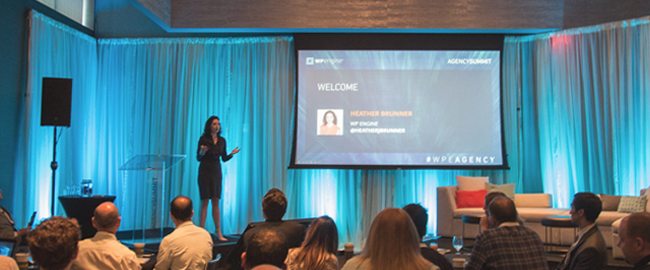How do you juggle today’s customers while also preparing for tomorrow’s audience? The answer is to create a real-time web experience.
As WP Engine’s inaugural Agency Summit began at the W Hotel in downtown Austin, WP Engine’s CEO Heather Brunner took the stage to give her keynote speech to discuss future audience needs in digital media.
Here are some insights as discussed by Brunner on the future of digital media and importance of creating a real-time web experience:
As technology changes so will how to measure success online
According to Brunner, today’s technology looks different than what it did 20 years ago. Brands have much more tools at their disposal to reach audiences like never before.
“I think over the next decade we will see an unleashing of technology like we’ve never seen before that is really going to change what success online looks like,” said Brunner.
What are tomorrow’s consumer’s expectations?

Today’s youth is looking for a personalized experience. Brunner used the popular ecommerce site Amazon.com as an example to show how personalization is the future of digital experiences. When you log into your Amazon account, you see a personalized web page with suggestions of products you might like. These products are tailored to your preferences based on past shopping experiences.
A global and social experience will allow users to connect and talk about your product. Online users want to share their experiences with others, therefore spreading the word. Brands can monitor what people are saying about their company by targeting regions and surfing social media.
Brunner also suggested making your digital media accessible on mobile devices, as today’s consumer is always on the go. Lastly, many companies are making the shift to vocal technology, such as Amazon with the Echo and Apple’s Siri. All of these aspects should be kept in mind when it comes to catering to consumer expectations and the future of technology.
“Our digital youth has rising expectations for us about what looks good online. They’re expectations are super high. They are unconsciously competent relating to digital. It is integrated into everything that they do from an early age. How they play, what they do at school, how they talk. Their digital intelligence is increasing and increasing and this is our future audience,” said Brunner.
Tomorrow’s audience expects a lot out of us and they want their expectations filled now — in real time.
How do we create the real-time web?
“One of the challenges we’re facing is how we architect the real time web. How do we build this new real-time web experience that changes how we assemble, how we design, and how we show our brands to our digital media users and all our global consumers? It has a lot of challenges but also tremendous opportunities,” said Brunner.
Brunner capitalized on open technology because of its agility and customization. She also encourages technologists and creatives to work together to figure out how to gather more data to create the real-time web.
Final thoughts

“Our youth will flock to the brands that know them, that give them value, that make them feel that there’s that change of value and that energizing and excitement about their product,” said Brunner.
She added, “In order to compete, customer experience will be the game. But it will be fueled by trust, because those brands we trust, we share more. And as we share more, these brands will become more intelligent. As brands become more intelligent, they will become more relevant, and as they become more relevant, we will become more loyal and more of a brand advocate. It’s a combination of great experiences, combined with that trust.”

Leave a Reply